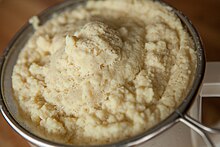Okara (food)
| Okara | |||||||||

Filtering okara from a fresh batch of homemade soymilk.
|
|||||||||
| Chinese name | |||||||||
|---|---|---|---|---|---|---|---|---|---|
| Chinese | 豆渣 / 豆腐渣 | ||||||||
|
|||||||||
| Japanese name | |||||||||
| Kanji | 雪花菜 / 御殻 | ||||||||
| Kana | おから | ||||||||
|
|||||||||
| Korean name | |||||||||
| Hangul | 비지 / 콩비지 | ||||||||
|
|||||||||
| Transcriptions | |
|---|---|
| Standard Mandarin | |
| Hanyu Pinyin | dòu zhā / dòufu zhā |
| Wade–Giles | tou4 cha1 / tou4fu cha1 |
| Transcriptions | |
|---|---|
| Revised Hepburn | okara |
| Transcriptions | |
|---|---|
| Revised Romanization | biji / kongbiji |
| McCune–Reischauer | piji / k'ongbiji |
Okara, soy pulp, or tofu dregs is a pulp consisting of insoluble parts of the soybean which remains after pureed soybeans are filtered in the production of soy milk and tofu. It is generally white or yellowish in color. It is part of the traditional cuisines of Japan, Korea, and China, and since the 20th century has also been used in the vegetarian cuisines of Western nations.
It is called dòuzhā or dòufuzhā in Chinese, okara in Japanese, and biji or kongbiji in Korean.
Okara is the oldest of three basic types of soy fiber. The other two are soy bran (finely ground soybean hulls), and soy cotyledon/isolate fiber (the fiber that remains after making isolated soy protein, also called "soy protein isolate").
Okara is a food by-product from tofu and soy milk production. In 1983 it was estimated that the annual yield for okara in Japan was approximately 70,000 metric tons.
Due to its high moisture and nutrient content, okara is highly prone to putrefaction, and this has limited its commercial use.
Okara that is firmly packed consists of 3.5 to 4.0% protein, 76 to 80% moisture and 20 to 24% of solids. When moisture free, okara contains 8 to 15% fats, 12 to 14.5% crude fiber and 24% protein, and contains 17% of the protein from the source soybeans. It also contains potassium, calcium, niacin.
Most okara worldwide is used as feed for livestock - especially hogs and dairy cows. Most of the rest is used as a natural fertilizer or compost, which is fairly rich in nitrogen. A small amount is used in cookery.
While relatively flavourless when eaten on its own, it can be used in stews such as the Korean biji-jjigae or in porridges. It's also used as an addition to baked goods such as breads, cookies and muffins, and can serve to create a crumbly texture in these foods.
...
Wikipedia
